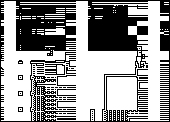


Italian version
.art

18.12.03 The Classic II Exhibition, art for old Macs.
Obsolete hardware surely is a resource, both from an aesthetical, a sort of 'vintage', and from a historical point of view, because it testimonies the evolution of the computer industry and the intrinsical limits it faced through the years. The swedish organization Electrohype, which has given the name to a festival, has capitalized on this possibility by opening, in its gallery in Malmö, 'The Classic II Exhibition', an exhibition of software art, both vintage and not, running on Apple Mac Classic II computers. The works are: 'HyperScape', by Richard Bolam, a software for manipulating an image on many machines, coordinating their work; 'The Artist's Eye', by Torrey Nommesen, a classic subversion of the point of view, realized with an on-screen eye watching the visitors; 'The Matrix 9x9', by Sebastian Campion, an asynchronous matrix made with nine pictures from the movie 'The Matrix' reduced to black and white in a grid of nine pixels; 'Liquid Language', by David Rokeby, a flow of text revolving around the concept of forgetting / remembering / dreaming; 'Classico Salz Bee Jul', by Mogens Jacobsen, patterns generated on the screen symmetrically with respect to the position of the mouse pointer; 'Arrow Variations - Book 1', by John F. Simon jr., an interactive prediction of the arrow movements by playing with a few parameters; 'ALRT#ID', by JODI, a work inspired by the mousepad as a projection plane of the computer; 'Auto', by Magnus Wassborg and 'Inferiorator', by Toree Nilsson, in a conceptual and contradictory union; and 'OutPut', by the italians Marotta & Russo, which uses the original cliparts of hypercard to self-referentially describe the historical period of information technology around the Nineties. It succeeds in brilliantly crystallize two phenomena: the availability and the parallel demand of hardware to create and show artworks and, thanks to the characteristics of the Apple Classic, the union of hardware and software in a unique objet d'art, which is just starting to become affordable and which, according to the organizers, challenges the impossibility to sell digital art.